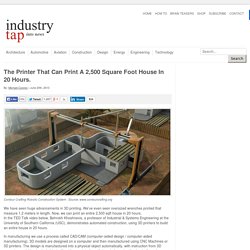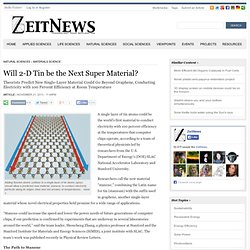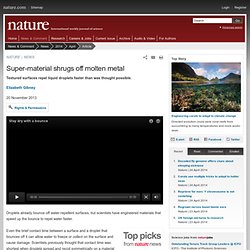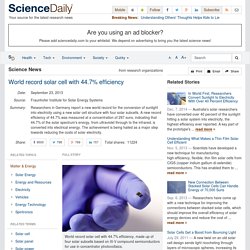

New State of Matter Discovered. There was a time when states of matter were simple: Solid, liquid, gas.

Then came plasma, Bose -Einstein condensate, supercritical fluid and more. Now the list has grown by one more, with the unexpected discovery of a new state dubbed “dropletons” that bear some resemblance to liquids but occur under very different circumstances. The discovery occurred when a team at the University of Colorado Joint Institute for Lab Astrophysics were focusing laser light on gallium arsenide (GaAs) to create excitons. Excitons are formed when a photon strikes a material, particularly a semiconductor. If an electron is knocked loose, or excited, it leaves what is termed an “electron hole” behind.
If this all sounds a bit hard to relate to, consider that solar cells are semiconductors, and the formation of excitons is one possible step to the production of electricity. 10 completely 3D printed houses appears in Shanghai, built under a day. April 1, 2014 Back in 2011, University of Southern California Professor Behrokh Khoshnevis said new technology will soon allow massive 3D printers to build entire multi-level houses in under a day.

A group of 3D printed houses, 200 m2 each, recently appears in Shanghai, China. These building were created entirely out of concrete using a gigantic 3D printer, and each costs only 30,000 RMB ($4,800). The company behind these 3D printed building, Shanghai WinSun Decoration Design Engineering Co, said it has for years been working on developing the system and its materials. Intricate 3D Printed Materials Lighter Than Water and as Strong as Steel. Using precision lasers, a Nanoscribe 3D printer can print models of the Empire State building in a space the width of a human hair.

Two College Kids Have Invented a New Cardboard Box. An AMAZING Cardboard Box. Cooper Union engineering students Henry Wang and Chris Curro have developed something that looks brilliant: a box that saves 15% on cardboard, requires no tape, and unfolds so easily that the recipient only needs to push in a flap to unpack the contents.

See their promotional video below: But Reddit gave the duo a hard time, asking whether or not the strip of wax would handle the 120 degree fahrenheit temperatures in summer delivery vans or if the box would accidentally open during shipping. Beyond 3D printing: The all-in-one factory - tech - 15 August 2013. 3D printing with graphene is coming, and it will change the world. Oct.19, 2013 Graphene is going to revolutionize the 21st Century.

As a emerging material Graphene could change the way electronic components are made. Graphene is a two dimensional material consisting of a single layer of carbon atoms arranged in a honeycomb or chicken wire structure. It is the thinnest material known and according to mechanical engineering professor James Hone, of Columbia University, graphene is strongest material ever measured, some 200 times stronger than structural steel. The Printer That Can Print A 2,500 Square Foot House In 20 Hours. - Industry Tap.
We have seen huge advancements in 3D printing.

We’ve even seen oversized wrenches printed that measure 1.2 meters in length. Now, we can print an entire 2,500 sqft house in 20 hours. In the TED Talk video below, Behrokh Khoshnevis, a professor of Industrial & Systems Engineering at the University of Southern California (USC), demonstrates automated construction, using 3D printers to build an entire house in 20 hours. In manufacturing we use a process called CAD/CAM (computer-aided design / computer-aided manufacturing). 3D models are designed on a computer and then manufactured using CNC Machines or 3D printers. The design is manufactured into a physical object automatically, with instruction from 3D computer model to physical object without human interface.
Will 2-D Tin be the Next Super Material? A single layer of tin atoms could be the world’s first material to conduct electricity with 100 percent efficiency at the temperatures that computer chips operate, according to a team of theoretical physicists led by researchers from the U.S.

Department of Energy’s (DOE) SLAC National Accelerator Laboratory and Stanford University. Researchers call the new material "stanene," combining the Latin name for tin (stannum) with the suffix used in graphene, another single-layer material whose novel electrical properties hold promise for a wide range of applications.
"Stanene could increase the speed and lower the power needs of future generations of computer chips, if our prediction is confirmed by experiments that are underway in several laboratories around the world," said the team leader, Shoucheng Zhang, a physics professor at Stanford and the Stanford Institute for Materials and Energy Sciences (SIMES), a joint institute with SLAC. Super-material shrugs off molten metal. Droplets already bounce off water-repellent surfaces, but scientists have engineered materials that speed up the bounce to repel water faster.

Enlightening stuff. Neat Stuff Published on December 16th, 2013 | by Woody Evans New research suggests that perovskites, a family of mineral compounds with special attributes, will improve both the lifespan and the efficiency of solar cells Perovskites are found in the Ozarks of Arkansas, in Sweden, Cameroon, and especially in the Russian Urals.

Chemically, it’s a three-dimensional latticework of calcium, titanium and oxygen. Recent work in Science and Nature shows perovskites’ applicability for improving solar energy generation. Kevin Bullis reports: “Unlike conventional solar cell materials, the new material doesn’t require an electric field to produce an electrical current. Polska rozpoczęła produkcję grafenu. Nasza metoda podbije świat? Beyond 3D printing: The all-in-one factory - tech - 15 August 2013. 3D PRINTERS are about to get an upgrade.
The latest not only prints objects, it can cut and etch them too, making it far more versatile. The Microfactory is a portable, self-contained machine just a little larger than an average desktop 3D printer. World record solar cell with 44.7% efficiency. The Fraunhofer Institute for Solar Energy Systems ISE, Soitec, CEA-Leti and the Helmholtz Center Berlin jointly announced today having achieved a new world record for the conversion of sunlight into electricity using a new solar cell structure with four solar subcells.

Surpassing competition after only over three years of research, and entering the roadmap at world class level, a new record efficiency of 44.7% was measured at a concentration of 297 suns. This indicates that 44.7% of the solar spectrum's energy, from ultraviolet through to the infrared, is converted into electrical energy. This is a major step towards reducing further the costs of solar electricity and continues to pave the way to the 50% efficiency roadmap.
Here come the 3D-printed 3D printers. The amoeba has a lot in common with a RepRap 3D printer. Why? Amoebas are able to self-replicate, just like a RepRap 3D printer can print parts of itself and essentially create a whole new RepRap machine. The First Carbon Nanotube Computer. For the first time, researchers have built a computer whose central processor is based entirely on carbon nanotubes, a form of carbon with remarkable material and electronic properties. See The Scientific Accident That May Change The World (Or At Least Your Battery Life) New miracle material poised to alleviate the global water and energy crisis. Image Credit / Wikimedia Commons By: Carolanne Wright, Natural News. Daunting observations made in the Population Institute report, “2030: The ‘Perfect Storm’ Scenario,” clearly illustrate the dire need for innovative solutions concerning the pending worldwide energy and water crisis. According to Science Daily, “With the world’s population expected to hit 8.3 billion by 2030, there will be a massive increase in the global demand for energy and food by 50 per cent and 30 per cent for drinking water.”
Yet, scientists at Nanyang Technological University (NTU) in Singapore have steadily worked over the last five years to create a seemingly miraculous material that produces hydrogen, creates clean water and can even generate energy – all at a very low cost in contrast to the current technology available. Filmy Dokumentalne.pl. Ultra-efficient LED puts out more power than is pumped in. MIT physicists have been testing a light-emitting diode that has an electrical efficiency of more than 100 percent. A Battery That Allows Electronics and Implants To Stretch Along With It.
Artificial Skin That's Way More Sensitive to Touch Than The Real Thing. This substance will let you turn your skin into a computer. More data storage? Here's how to fit 1,000 terabytes on a DVD. Corrosion Control & Waterproof Coatings. Scientists design new adaptive material inspired by tears. Nielegalne drukowanie rzeczywistości. Algae-powered apartment complex blooms in Hamburg. The pure core organic life mirror. P i c t u r e d : hub and strut wood frame dome for studio and living spaces / collapseable shelter system and growing dome for food production.
Robohand: How cheap 3D printers built a replacement hand for a five-year old boy. The World’s First 3D-Printed Building Will Arrive In 2014 (And It Looks Awesome) Sure, 3D printing is fun and cute. The World’s First 3D-Printed Building Will Arrive In 2014 (And It Looks Awesome) Aerogel.org. Liquid Armor.